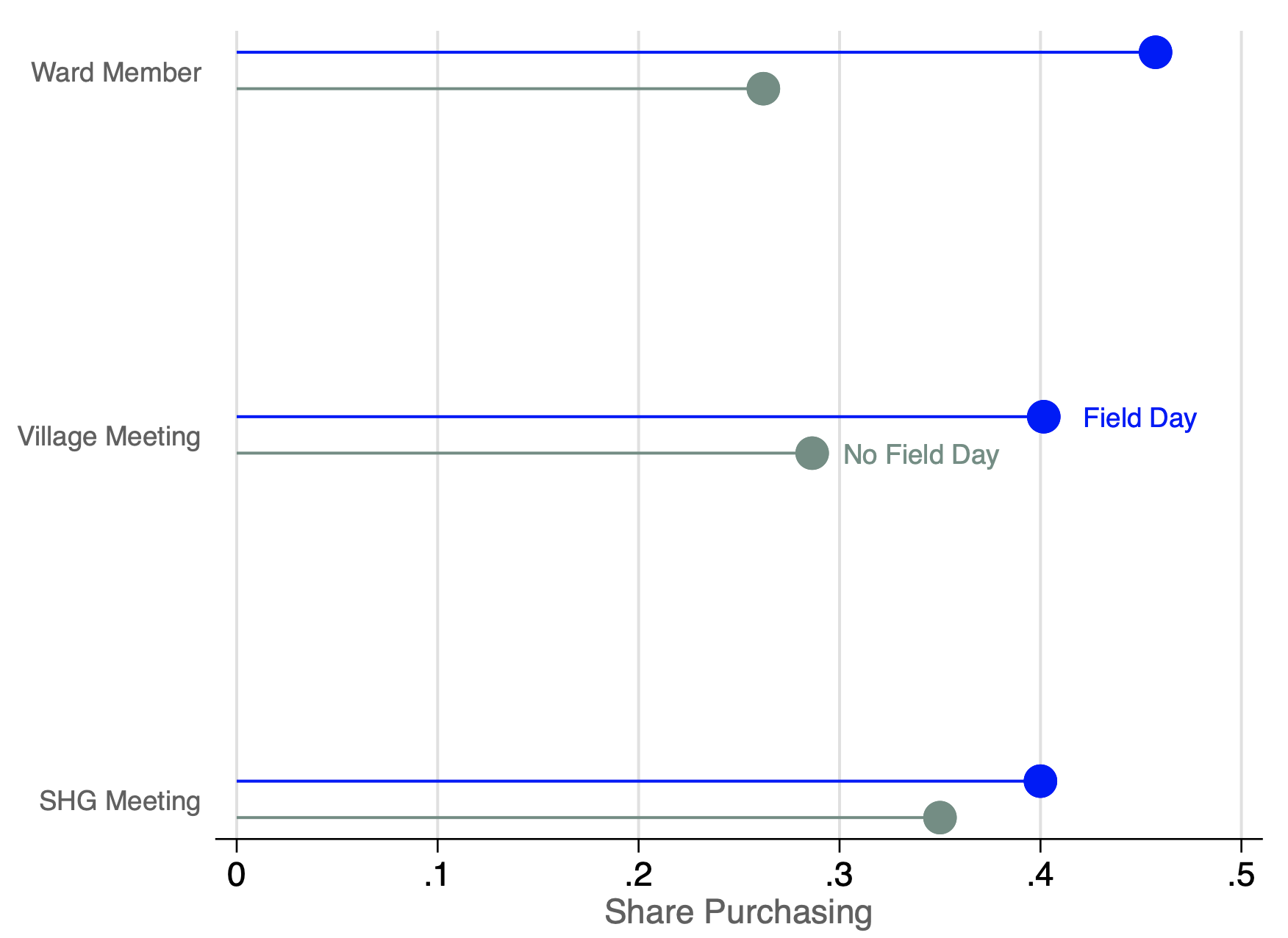
Training field days increase awareness and adoption of technology, irrespective of how the demonstrators are selected
Agriculture accounts for most of the labour force in developing countries, but productivity per worker remains lower than in other sectors (Restuccia et al. 2008, Gollin et al. 2014). While improved technology may help close this productivity gap, researchers have identified several factors that constrain the adoption of profitable technologies by smallholder farmers. Among these, lack of information and learning represents a prevalent barrier (Magruder 2018) to technology adoption.
The public sector uses a variety of tools to help farmers learn about new technologies. Recent empirical studies have evaluated different policy interventions, which include selecting initial adopters of the technology to optimise the diffusion of information or incentivising them to spread information (Beaman et al. 2021, BenYishay and Mobarak 2018). However, finding scalable ways to improve learning and access to information remains a key policy goal.
An experimental evaluation of methods to increase learning
In Emerick and Dar (2021), we study two ways to aid farmers in learning. The first is the selection of early adopters of the technology; the second is field day trainings undertaken later in the season to engage farmers in learning. We start by introducing Swarna-Sub1 – an improved flood-tolerant rice variety – to five farmers in 100 villages in Odisha India. Previous work has found that the variety benefits farmers by reducing the risk of crop damage by floods (Emerick et al. 2016). The five farmers – whom we call ‘demonstrators’ – were selected in one of three ways:
- by the locally elected village ward member in 33 villages,
- with participatory village meetings in 34 villages, or
- with meetings of self-help groups (SHGs) in 33 villages (SHGs are groups of women that organise to help empower women).
We then cross-randomised these 100 villages into two groups. In half of the villages, we organised ‘farmer field days’ where a representative from a local NGO organised the farmers into a meeting to talk about Swarna-Sub1. The demonstrators and other interested farmers attended the meetings, with over 40 attendees on average. This approach contrasts with the comparison villages where we did not facilitate learning through field days. Rather, farmers relied on information diffusion through their networks.
We measure our key outcome of interest using door-to-door sales of Swarna-Sub1 to 15 randomly selected farmers per village before the next season. These data provide an objective measure of adoption at market prices that we can compare across the treatments.
Farmer field days increased learning and technology adoption
We find that the field days taught farmers more about Swarna-Sub1 and increased their adoption (Figure 1). Across the three ways of selecting demonstrators, about 30% of farmers bought Swarna-Sub1 seeds in villages where there were no field days, with adoption increasing to approximately 42% in the field day villages. This result coincides with farmers learning more in field day villages. In particular, farmers in field day villages spoke more to other farmers and were more likely to answer correctly when asked about certain attributes of the variety. There are no statistical differences in the effectiveness of field days across the different methods of demonstrator selection.
Figure 1 Share of farmers buying technology for each treatment

The selection method for demonstrators was less important
Changes to the demonstrator selection process did not have significant effects on adoption. In the absence of field days, adoption was greatest in villages where we selected demonstrators through SHG meetings (Figure 1), but none of these differences is statistically significant. Although the village meetings did lead to the selection of demonstrators that were less connected to the ward member, this did not translate into adoption gains in our setting.
How encouraging farmers to learn can increase adoption
Governments commonly use demonstrators, or ‘contact farmers’, to introduce new agricultural technologies. Our study shows that once these demonstrators have been identified, farmer field days can assist in the learning process and also increase adoption. This could be because farmers need to gather opinions from more people (either the NGO, perhaps, or other villagers that were not demonstrators). We conclude that policy interventions that engage farmers in learning can be effective compared to relying solely on local networks to transmit information. Identifying other interventions that assist the learning process in this way can be a fruitful area for future work.
References
Beaman, L, A BenYishay, M Mobarak, and J Magruder (2021), “Can Network Theory based Targeting Increase Technology Adoption?” American Economic Review 111(6): 1918–1943.
BenYishay, A and A Mushfiq Mobarak (2018), “Social Learning and Incentives for Experimentation and Communication”, The Review of Economic Studies 86(3): 976–1009.
Emerick, K and M. H Dar (2021), “Farmer field days and demonstrator selection for increasing technology adoption”, Review of Economics and Statistics 103(4): 680–693.
Emerick, K, A de Janvry, E Sadoulet, and M. H Dar (2016), “Technological Innovations, Downside Risk, and the Modernization of Agriculture”, American Economic Review 106(6): 1537–1561.
Gollin, D, D Lagakos, and M. E Waugh (2014), “The agricultural productivity gap”, The Quarterly Journal of Economics 129(2): 939–993.
Magruder, J. R (2018), “An assessment of experimental evidence on agricultural technology adoption in developing countries”, Annual Review of Resource Economics 10:299–316.
Restuccia, D, D. T Yang, and X Zhu (2008), “Agriculture and aggregate productivity: a quantitative cross-country analysis”, Journal of Monetary Economics 55(2): 234–250.

